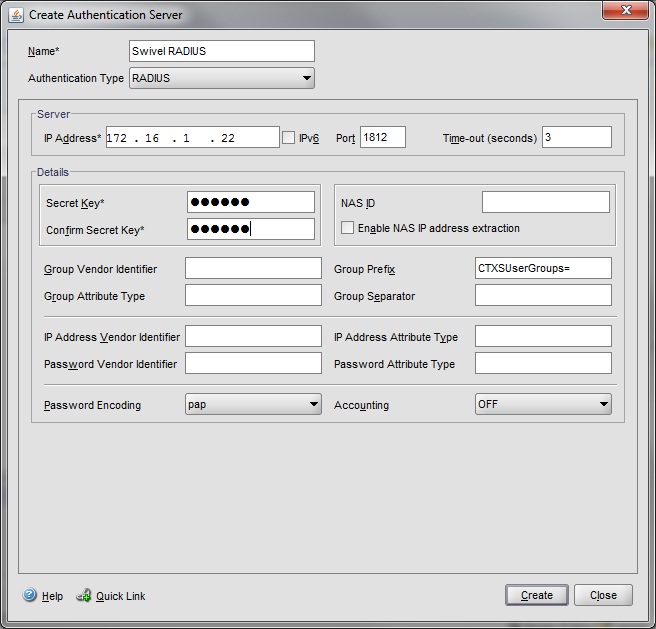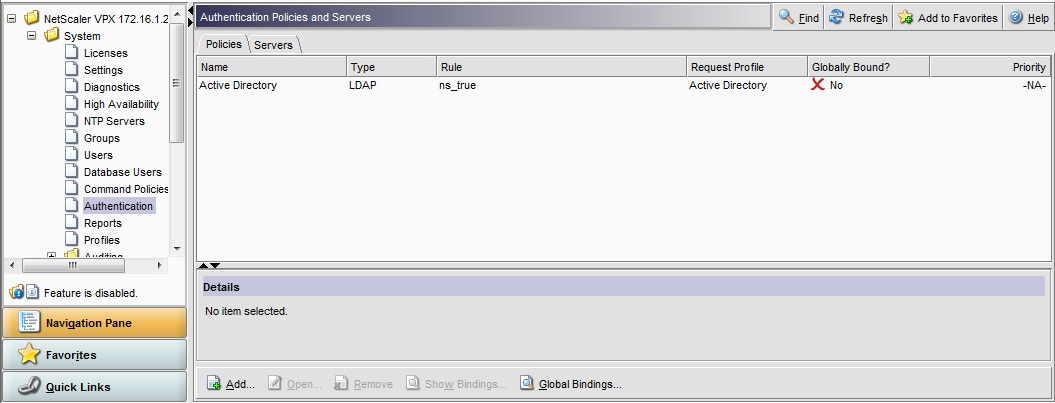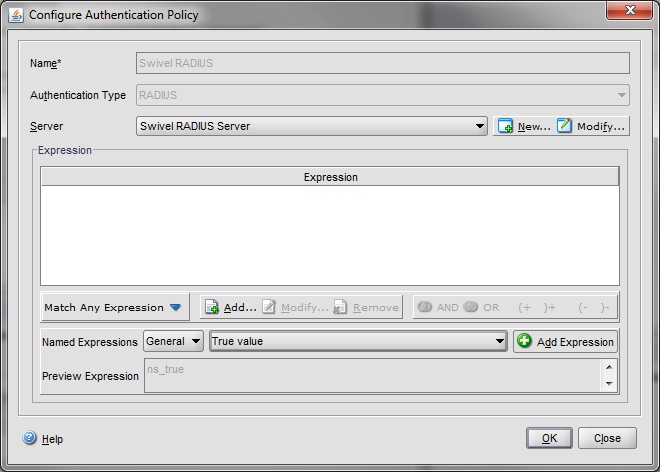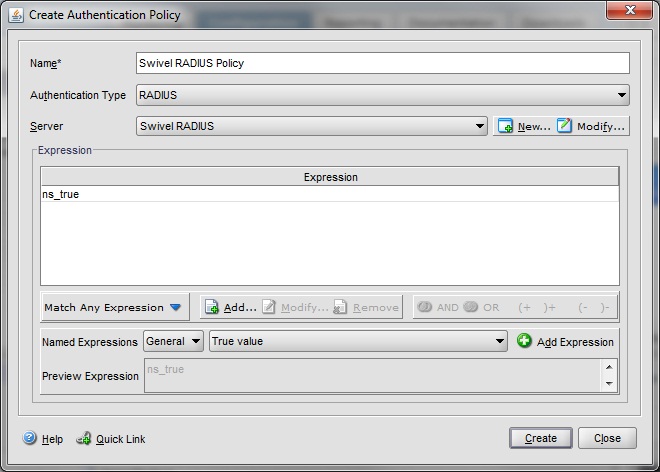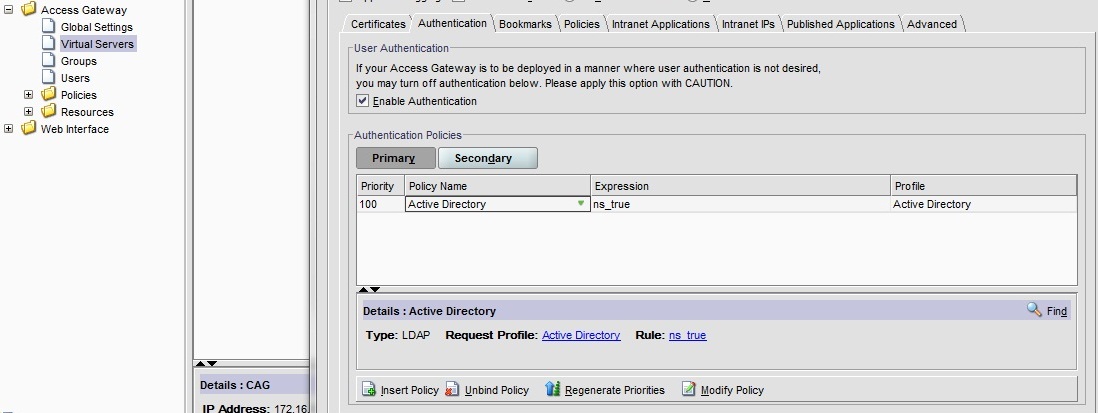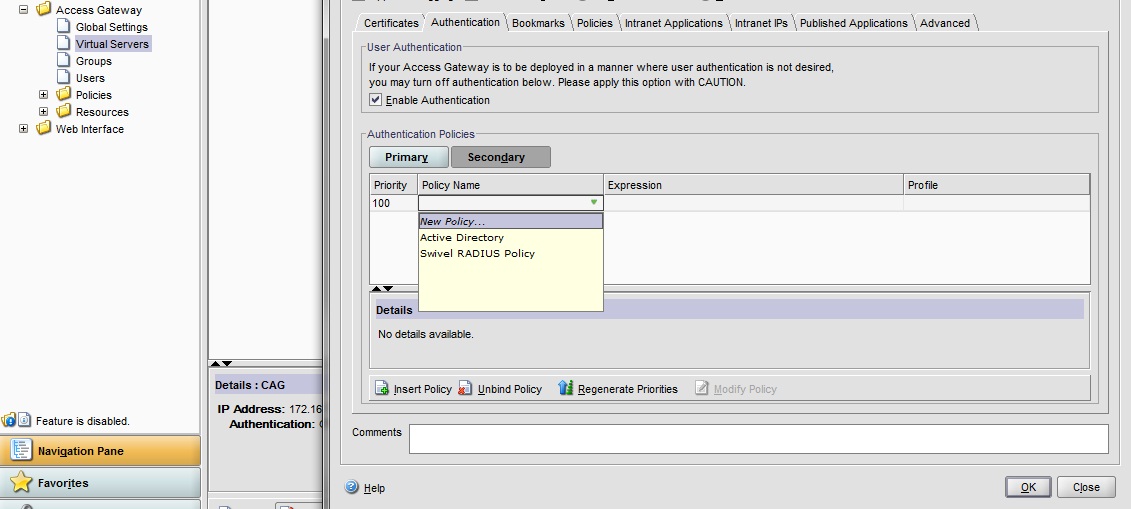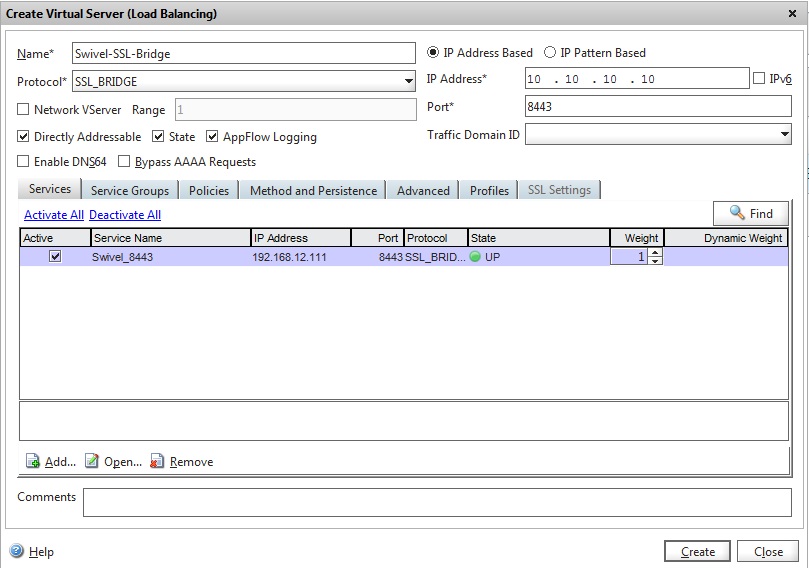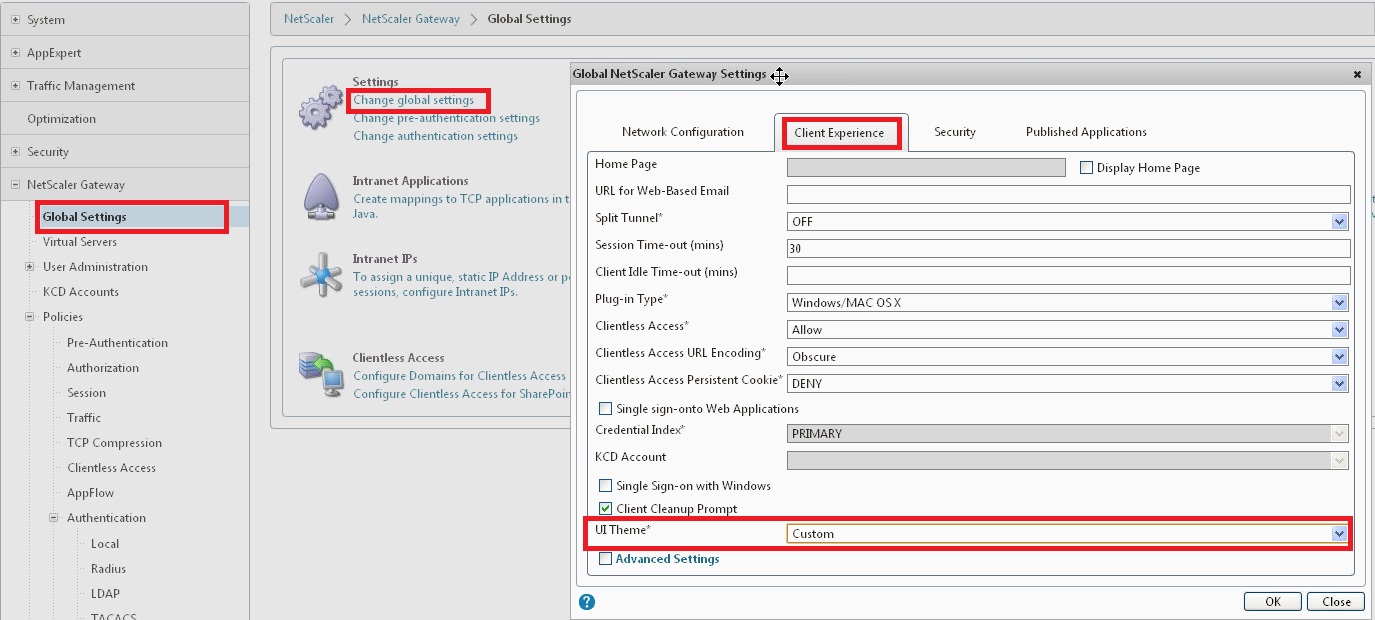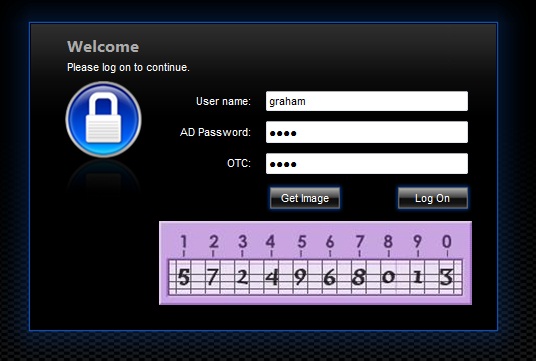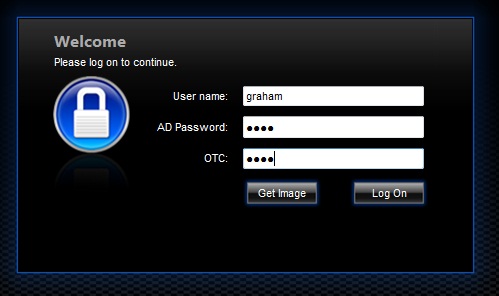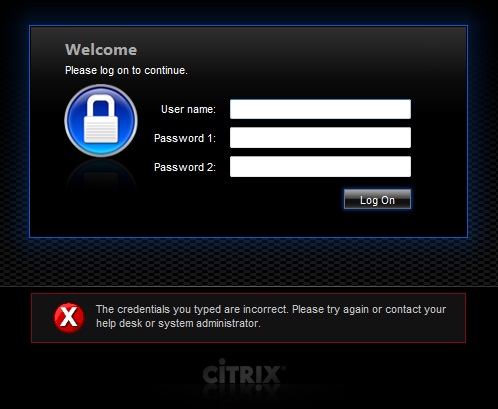Citrix Netscaler Gateway 10.x
Contents
[hide]- 1 Introduction
- 2 Prerequisites
- 3 Baseline
- 4 Architecture
- 5 Swivel Configuration
- 6 Citrix Netscaler Gateway Configuration
- 7 Additional Configuration Options
- 7.1 Netscaler RADIUS Monitor and RADIUS Load Balancer
- 7.2 Netscaler SSL Bridge
- 7.3 Login Page Customisation
- 7.4 Upgrading Netscalers with Custom Pages
- 7.5 Customisation Overview
- 7.5.1 Login to Netscaler Command Line
- 7.5.2 Backup Netscaler files
- 7.5.3 Customise the login script
- 7.5.4 Customise the login prompt
- 7.5.5 Upload files to Netscaler
- 7.5.6 Create the boot archive file
- 7.5.7 Tell the Netscaler to use the customised login pages
- 7.5.8 Reboot Netscaler to verify files are copied across
- 7.6 Additional Login Customisation options
- 7.7 Challenge and Response
- 7.8 Image Request button displayed when needed
- 8 Testing
- 9 Uninstall/Removing the integration
- 10 Troubleshooting
- 11 Known Issues and Limitations
- 12 Additional Information
Introduction
This document shows the steps required to integrate Swivel with the Citrix Access Gateway Enterprise Edition 10.1 and 10.5 (Netscaler VPN). Swivel can provide Two Factor authentication with SMS, Token, Mobile Phone Client and strong Single Channel Authentication TURing, Pinpad or in the Taskbar using RADIUS.
For version 10.0 refer to Citrix Access Gateway Enterprise Edition 10
For versions 8.x to 9.1 refer to Citrix Access Gateway Enterprise Edition 8,
For other versions of 9.x see Citrix Access Gateway Enterprise Edition 9.
It covers the following steps.
- Configuring Swivel to accept authentication requests from the CAGEE
- Modifying the CAGEE login pages
- Configuring the CAGEE to authenticate via PINsafe
To use the Single Channel Image such as the TURing Image, the Swivel server must be made accessible. The client requests the images from the Swivel server, and is usually configured using Network Address Translation, often with a proxy server. The Swivel virtual or hardware appliance is configured with a proxy port to allow an additional layer of protection. The Netscaler can be configured using its load balancing bridging feature to allow a Swivel Severs IP to provide Single Channel images, such as TURing and PINpad.
Citrix Netscaler 10.5 has a new HTML GUI interface for management, although the customisation pages using java script remains the same.
Prerequisites
Access Gateway Enterprise Edition firmware version 10.1 or higher
An administrative logon account for the Access Gateway
A Secure Shell (SSH) programme (eg putty) and an SSH-based file transfer application such as WinSCP
A Unicode-aware text file editor such as TextPad or WordPad
Swivel 3.x
Swivel server must be accessible by client when using Single Channel Images, such as the Turing Image, this is usually implemented by a NAT to the Swivel server. Ensure that only the required ports are allowed access.
Netscaler pages to modify and/or Swivel files for version 10.x default theme or the Green Bubble 10.x theme
The following pages are for 10.5: only the language resources are different from 10.x. Version 10.5 default theme. Green Bubble 10.x theme.
Note on upgrading the Netscaler
When upgrading see the note below if custom pages are used upgrading Netscalers with Custom Pages
Baseline
Tested with Swivel 3.9.6
Citrix Netscaler Gateway NS10.1 Build 121.10
Citrix Netscaler Gateway NS10.5
Architecture
The Citrix Advanced Access Gateway Enterprise Edition makes authentication requests against the Swivel server by RADIUS.
You can create different logon realms / pages called Virtual Servers, these can have different authentication servers/policies, SSL certificates and resources attached to them. However, the downside is they ALL use the same index.html/login.js/en.xml files, so you cannot have multiple landing pages with/without the Swivel modifications.
Swivel Configuration
Configuring the RADIUS server
On the Swivel Administration console configure the RADIUS Server and NAS, see RADIUS Configuration
Enabling Session creation with username
To allow the TURing image, PINpad and other single channel images, under Server/Single Channel set Allow session request by username to Yes.
Setting up Swivel Dual Channel Transports
Citrix Netscaler Gateway Configuration
The Swivel integration uses RADIUS authentication, and where the login page is modified it uses the Netscaler custom web pages which are configured and then copied into an archive file which is deployed at boot time.
Citrix Advanced Access Gateway Enterprise Edition RADIUS Configuration
The CAGEE needs to be configured to use the Swivel server as a RADIUS authentication server. Where several Swivel virtual or hardware appliances are used for resilience, configure the RADIUS request to be made against each of the Swivel servers together with the use of Session Sharing. Note: for virtual or hardware appliances, the Swivel VIP should not be used as the RADIUS server IP address, see VIP on PINsafe Appliances
Swivel can be configured as the only authentication server or as an additional authentication server, usually this would be together with AD. The required steps are pretty much the same for both scenarios.
Under the Netscaler->System->Authentication select the Servers Tab and then click add, enter the following information:
Name Swivel RADIUS
Authentication type RADIUS
Secret Key The secret key configured on the Swivel NAS and also under Confirm Secret Key
Group Prefix CTXSUserGroups=
Group Separator ;
When complete click on Create.
If the Authentication option is not available check that the license allows authentication to be configured on the Netscaler licensing page.
Under the Netscaler->System->Authentication select the Servers Tab and then click add, enter the following information:
Name Swivel RADIUS Policy
Authentication Type RADIUS
Server Swivel RADIUS
Named Expression True Value (Then click Add Expression so ns_true appears under Expression
The authentication must be then added such as the Access Gateway/Virtual Servers menu. If just Swivel authentication is required then ensure that only the Swivel policy is active for the Primary. If you require AD and Swivel authentication then you need to make active the Swivel policy as the secondary. Save the settings.
Citrix Receiver with Netscaler configuration
See Citrix Netscaler configuration for Receiver
Additional Configuration Options
Netscaler RADIUS Monitor and RADIUS Load Balancer
See Citrix Netscaler RADIUS Monitor and RADIUS Load Balancer
Netscaler SSL Bridge
The Netscaler allows a SSL Bridge to be created that allows a Network Address Translation to allow access to the Swivel instance to provide single channel images or Mobile App security strings. On the Netscaler Gateway Administration Console Configuration tab select Traffic Management, Load balancing, Virtual Servers, then click on Add, to open a Create Virtual Server (Load Balancing) window.
The Netscaler requires an external NAT to the Swivel server, and the Netscaler Network bridge allows this to be done using the Netscaler. The Swivel appliance is usually use to provide the proxy port on 8443 or 443
Name Name of the SSL Bridge
Select IP Adress Based
Protocol select SSL_Bridge
IP address Enter the public IP Address
Port Enter the Swivel instance port number, usually 8443
The following should be ticked Directly Accessible', State, AppFlow Logging
Click Add and enter the required details.
Service Name Name of the SSL Bridge
Server Swivel server address
Protocol select SSL_Bridge from the drop down menu
port select the port used to connect to the SSL bridge, usually 443
From the Monitors tab select TCP then Add it to the list of Configured so that it appears on the right hand side with the State box checked., then click on Create.
Login Page Customisation
This step only needs to be followed if login page customisation is required.
Upgrading Netscalers with Custom Pages
Citrix recommend when upgrading a Netscaler with custom pages, the custom pages should be set back to use default pages, upgrade and then the custom pages reapplied. When upgrading it is recommended to make a backup or snapshot of the existing system.
When upgrading a Netscaler 10.1 with custom pages to 10.5, backup the modified pages and scripts, then set the login page back to default. Upgrade, test the Administration console, then upload the modified pages as if carrying out a new Swivel install as given below, then recreate the custom tar file as below as this will then include the updated GUI.
Customisation Overview
One Touch
One touch is a different approach as the user is redirected to a separate page to authenticate and therefore does not actually see the Netscaler login page.
Refer to VPN_OneTouch_Integration
To customise the page for one touch you need to include the following in the header section of index.html where <swivelappliance> is the hostname of the associated Swivel Appliance
//-->
//-> Swivel elements
function redirect(){
window.location.replace("https://<swivelappliance>:8443/onetouch/onetouch?returnurl=" + window.location.href );
}
var QueryString = function () {
// This function is anonymous, is executed immediately and
// the return value is assigned to QueryString!
var query_string = {};
var query = window.location.search.substring(1);
var vars = query.split("&");
for (var i=0;i<vars.length;i++) {
var pair = vars[i].split("=");
// If first entry with this name
if (typeof query_string[pair[0]] === "undefined") {
query_string[pair[0]] = pair[1];
// alert(pair[0] + "," + pair[1]);
// If second entry with this name
} else if (typeof query_string[pair[0]] === "string") {
var arr = [ query_string[pair[0]], pair[1] ];
query_string[pair[0]] = arr;
//alert(pair[0] + "," + arr);
// If third or later entry with this name
} else {
query_string[pair[0]].push(pair[1]);
}
}
return query_string;
} ();
$(document).ready(function(){
usernamePassedIn = QueryString["username"];
passwordPassedIn = QueryString["password"];
if(typeof passwordPassedIn == 'undefined') {
redirect();
} else {
$('[name=passwd]').val(passwordPassedIn);
$('[name=login]').val(usernamePassedIn);
//alert("GO " + usernamePassedIn);
document.getElementsByName("vpnForm")[0].submit();
}
});
Before the closing </SCRIPT> tag
See under prerequisites for the modified files that need to be uploaded to the Netscaler.
Note on editing files: If the files are edited in Winsdows based systems it may be possible that control code ^M are added to the end of the line. These can be viewed and removed by using vi.
The below describes how to modify the login page for additional functionality such as the below which require the Swivel server to be accessible by the client, usually through a NAT:
- TURing Image (Automatic or requested by a button)
- Display Security String Index
- Get SMS button
Because all files in /netscaler/ns_gui are overwritten upon a restart or power cycle, they are incorporated into the archive deployed at boot time.
Login to Netscaler Command Line
Use WINscp to use a web file tool or SSH onto the virtual or hardware appliance using an admin account. Once onto the box you need to type shell to get access to the command line.
>Last login: Wed Sep 10 19:12:45 2008 Done > shell Last login: Wed Sep 10 21:13:35 2008
Backup Netscaler files
Navigate to the location of the pages to be modified, and make a local backup copy of them.
cd /netscaler/ns_gui/vpn cp index.html index.html.bak
Customise the login script
The login page can be customised using the standard theme or the Green bubble theme, or possibly another theme. Download the required theme from the pre-requisites above. Note that to use the customised Green Bubble theme, you first have to select the standard Green Bubble theme, then apply the customisation.
Requesting a TURing image
These files can be modified before uploading
Modify pinsafe.js. The pinsafeUrl variable value in pinsafe.js needs to be changed to reflect the Hostname and port number of the relevant Swivel server.
For an virtual or hardware appliance this will normally be similar to:
pinsafeUrl="https://turing.swivelsecure.com:8443/proxy/";
For a software only install see Software Only Installation
Customise the login prompt
Modify the language resource files in /netscaler/ns_gui/vpn/resources. If you are only using the English language, then edit en.xml and search for
<String id="Password2">
this should be around line 59.
Replace the value for id="Password2" with "OTC:". Also, insert a new string for id="Password" with a value of "AD Password". You should therefore have 2 lines as follows:
<String id="Password">AD Password</String> <String id="Password2">OTC:</String>
(Note that Password1 has no colon at the end, whereas Password2 has a colon).
Additional Languages file modifications
If you will be using languages other than English, you will also need to edit any other language files you use, replacing the value for Password2 with the appropriate label for OTC (One-time code) and inserting a new string for Password1 with the label for AD (Active Directory) password.
Edit the file rc.netscaler to copy across any modified language pages, as for English which is included in the script.:
cp /var/mods/en.xml.mod /var/netscaler/gui/vpn/resources/en.xml
Upload files to Netscaler
On the Netscaler ensure that either the default or green bubbles theme is used. On the Netscaler Gateway, select Netscaler Gateway/Global Settings, then click on Change Global Settings, and under the Client Experience tab check the UI Theme. After modifying the pages, this will be set to custom.
Download the files under the prerequisites and modify as described above, then copy them to the following locations:
index.html to /var/netscaler/gui/vpn/index.html
pinsafe.js to /var/netscaler/gui/vpn/pinsafe.js
Create the boot archive file
mkdir /var/ns_gui_custom cd /netscaler tar -zcvf /var/ns_gui_custom/customtheme.tar.gz ns_gui/*
This should create the customtheme.tar.gz file used at boot time, and list all the files used.
Tell the Netscaler to use the customised login pages
/netscaler/ns_gui is a symbolic link that by default points to /var/netscaler/gui, by setting the custom login, this link changes to the custom pages i.e. /var/ns_gui_custom/ns_gui. Therefore it is important that the above boot archive be created before switching to custom. Also note that WinSCP may cache the symbolic link and give the wrong location, so may need to be refreshed in the /netscaler folder.
On the Netscaler Gateway, select Netscaler Gateway/Global Settings, then click on Change Global Settings, and under the Client Experience tab change the UI Theme to Custom, then click on OK
Note: If the Netscaler pages are changed back from Custom to Default, then the index.html is replaced with the defaault index.html, and if a new custom page is required, then the custom index.html will need to be copied back.
Reboot Netscaler to verify files are copied across
Reboot the Netscaler to ensure that the files are copied across at boot time and that the login page has been modified as required.
Additional Login Customisation options
Automated TURing Display
With the automated TURing display, when the user leaves the username field, the TURing will be automatically displayed. A login using the TURing image is expected for that user.
Edit the index.html file
search for onFocus="loginFieldCheck()"
Add a new attribute after this, as follows:
onBlur="showTuring()"
Example:
onFocus="loginFieldCheck()" onBlur="showTuring()" style="width:100%;"
Changing the button labels
If you want to want to change the button text such for sending security strings to SMS or email on-demand, rather than showing a TURing image, or change the GET Image text you may want to change the label of the button. You can do this as follows:
Edit the index.html file and locate the code that renders the button by searching for "btnTuring". You will find the following code within the line:
id="btnTuring" value="Get Image"
Change the value attribute to an appropriate alternative, such as "Send Message".
Requesting the string Index
See also Multiple Security Strings How To Guide
Modify pinsafe.js. The pinsafeUrl setting in pinsafe.js needs to be changed to reflect the hostname and port number of the relevant Swivel server.
For a virtual or hardware appliance this will normally be similar to:
pinsafeUrl="https://turing.swivelsecure.com:8443/proxy/DCIndexImage?username=";
For a software only install see Software Only Installation
PINpad
This is a version of the 9.3 customisation modified for Pinpad. Currently in beta testing. Note that in order to use PINpad you will need a Swivel virtual or hardware appliance with the latest proxy application installed. You can get this from here.
Requesting an SMS
See also Challenge and Response below
Modify pinsafe.js. The pinsafeUrl setting in pinsafe.js needs to be changed to reflect the hostname and port number of the relevant Swivel server.
For an virtual or hardware appliance this will normally be similar to:
pinsafeUrl="https://turing.swivelsecure.com:8443/proxy/DCMessage?username=";
For a software only install see Software Only Installation
Challenge and Response
Citrix Access Gateway Enterprise Edition 9.2 and 10.x support RADIUS Challenge and Response. RADIUS Challenge and Response can be optionally configured to enter a username and Password, which will then ask for a One Time Code. Configure the Swivel server to use Two Stage Authentication and Check Password With Repository, see also Challenge and Response How to Guide
Challenge and response is usually configured with Username, and AD password for LDAP authentication, and Swivel configured to use AD password in order to request the SMS message to be sent to the user. It is possible to modify the login page so that the AD password need only be entered once. A modified page can be downloaded from here: CAGEE Two Stage Login page
To install the login page use the same procedure as the Single Channel login page.
If Single Channel is not being used at all, then a TURing image is not required. Therefore, if you configured a message Resend button (which would replace a Show Image button), then in the pinsafe.js, the parameter:
onclick= "showTuring();"
Must be changed to:
onclick= "sendMessage();"
Optionally, you can remove the showTuring function altogether. Which is in addition to the above step of changing onClick=.
Example fucnction code:
function showTuring() {showImage(pinsafeUrl + "SCImage");}
Image Request button displayed when needed
The following code allows the Single Channel Image request button to be only shown when required. This is useful for refreshing an image or when SMS/Mobile client authentication is used, since when a Single Channel image is generated, either automatically or manually, it then expects a single channel login (within 2 minutes by default).
function ns_showpinsafe()
{
var pspwc = ns_getcookie("pwcount");
if ( pspwc == 2 )
{
document.write('<td>');
document.write('<input type="button" id="btnTuring" value="Get Image" ');
document.write('onclick="showTuring();" class="CTX_CaxtonButton" ');
document.write('onmouseover="this.className=');
document.write("'CTX_CaxtonButton_Hover';");
document.write('" onmouseout="this.className=');
document.write("'CTX_CaxtonButton';");
document.write('" />');
document.write('</td>');
}
}
Testing
Browse to the login page and check that a Turing image appears and the One time Code can be entered to login.
For SMS or Mobile Phone Apps do not click on the Get Image button, but enter the OTC
If the incorrect credentials are used then the login should fail
Where the TURing image is not used, then the Get Image page modification can be omitted
Uninstall/Removing the integration
If the login pages have been modified restore the default login page and remove the added files.
Remove Swivel as the authentication server.
Troubleshooting
Check the Swivel logs for Turing images and RADIUS requests.
Image from PINsafe server absent
The CAGEE Netscaler checks each password/OTC in turn, so if the AD password is checked first and is incorrect then the secondary authentication will not be tested.
Error Messages
Files moved but have a ? appended to the end
If the script to move the files on login contains the control code ^M at the end of each line (usually introduced by Windows based text editors), then the files may appear with a ? at the end of the filename. Use vi to remove the ^M
Username field length incorrect
If the username field is too short it can be increased. Edit the index.html file and locate the below section setting the size="40"
<td align="right" style="padding-right:10px;white-space:nowrap;"><span id="User_name" class="CTXMSAM_LogonFont"></span></td> <td colspan=2 style="padding-right:8px;"><input id="Enter user name" class="CTXMSAM_ContentFont" style="font-size: 8pt" type="text" title="" name="login" size="40" maxlength="127" onFocus="loginFieldCheck()" style="width:100%;" /></td>
login command failed over API. Reason: Response not of type text/xml: text:html
This error can be seen on the Netscaler Administration console when upgrading with a custom theme. This will preventy login to the Netscaler Administration, although the user login pages should continue to work. To enable login to the Administration console, login to the Netscaler through the command line, backup and then and edit the /nsconfig/ns.config file and set the CUSTOM page to DEFAULT.
Look for the line containing -UITHEME CUSTOM and change it to DEFAULT as below:
set vpn parameter -localLanAccess ON -defaultAuthorizationAction ALLOW -proxy BROWSER -clientCleanupPrompt OFF -forceCleanup none -clientOptions all -clientConfiguration all -clientDebug debug -wiPortalMode NORMAL -ClientChoices ON -clientlessVpnMode ON -clientlessModeUrlEncoding TRANSPARENT -clientlessPersistentCookie ALLOW -UITHEME DEFAULT -kcdAccount NONE
After making the changes, reboot the system to login.
Known Issues and Limitations
The CAGEE caches the javascript so when you make modifications on the CAGEE they are not reflected on the log-in page as rendered. A way round this is to change the name of the .js file and edit the index.html file to use this new .js file. see [1]
Additional Information
For assistance in the Swivel installation and configuration please firstly contact your reseller and then email Swivel Secure support at support@swivelsecure.com

